Personal artillery
My acquaintance with weapons in general, and with grenades in particular, began at the age of fourteen. On one of the beautiful August days of 1941, the quiet lane where I lived was suddenly filled with trucks. German soldiers began jumping out from under their tents. Some of them occupied our rather large yard, and the newly planted apple trees were mercilessly crushed by the wheels of the cars that stopped by.
Strange-looking columns strolled along the street — the military in khaki uniforms and the same color of pillows, each with a long, faceted bayonet with a round wooden handle dangling from its side. Unlike the Germans, they looked completely unseemly. Running up to the convoy, I asked one of them, “Who are you?” The soldier, lifting his tired eyes at me, said in a monstrous fashion: “Ukrainian.” Another answered "Rusin". It seems that it was the Croatian part.
Somehow, returning to our own backyard, my friend and I, squeezing between closely-standing cars, noticed four German hand grenades with long wooden handles in the grass under the fence. The Germans, meanwhile, having built themselves with kettles in their hands, went to the field kitchen located nearby. The cars had only one watch with a carbine on the shoulder and with the same grenade just behind the belt. Without saying a word to my friend, we looked at each other and waited when the sentry turned away, instantly threw grenades over the fence into my yard. There, having fiddled a bit with them and not understanding anything in them, we approached the sentry and innocent physiognomies started a conversation with him. When asked what it was in his belt, he at first dismissed it, saying that it was not a childish thing, but then, giving in to our urgent requests, he took out a grenade from his belt, screwed the warhead and showed how the detonator was installed there, then separated the bottom cover and showed a porcelain reel with a white cord, which had to be pulled out before the throw.
As time went on, a “new” power was established in the city, in general there were two of them, one is Ortskommandantur — the local military commandant's office, the second, civil, represented by the city government. A yellow-blakitny flag with a black trident fluttered over the board. Then I still could not imagine that in a couple of years I would have to be in the war in the ranks of the Polish Army, who had to tinker a lot with Bandera's rage that was rampant in Ukraine under the same banner.
My peers and I were not interested in politics at that time, and therefore we were interested in completely different things, namely: we strenuously sought out and collected various weapons. These were mainly our trilineers, self-loading SVT and German Mauser rifles, various ammunition and hand grenades. The rifles were difficult to store because of their size, so we quickly learned how to trim them. Best of all for this was our three-ruler, from the neck of the butt of which there was a good handle of cutting. From the Mauser rifle this did not work, and even to cut the barrel was much more difficult than ours. My “hobby” (although this word was not yet known) was hand grenades and various kinds of fuses. Each of us kept our own meeting, of course, not at home, but in a carefully disguised “shove”. It was not considered to track down the “framing” of a colleague and rob it of a special sin.
From time to time we looked for a secluded place to test our exhibits. Especially we were impatient to check in action hand grenades, which in our company had already gathered three types. I traded one of my German M-24 on RGD-33 with a fuse from Genka Arkhangelsky, nicknamed the "red dog" for a face full of freckles. Our friend, nicknamed "Shepil" boasted a grenade, which he rested against the Hungarian soldiers who were lodging in his house. It was a black barrel with three red cross strips and a check with a tongue of thick yellow skin. For their testing, we chose a secluded spot on the river bank opposite the deep pool. The first to come out was the “red dog” with the once my German M-24, almost universally nicknamed the “tolkushka.” When Genk pulled out a porcelain reel with a cord from it, there was not the slightest sound, and he even hesitated, thinking that a misfire had occurred. But he had enough mind to throw it all the same. Grenade exploded, drowned at the bottom of the pool. The sound of the gap was not particularly strong. Next was my turn. I must say that it was the first throw of a grenade in my life, and I was a little afraid, inserting a fuse into a cocked grenade ahead of time. RGD-33, barely flying out of my palm, made a loud bang and also burst at the bottom with about the same effect as the German one. The Madyar grenade behaved quite unexpectedly for us - about a half of the trajectory a black cap separated from it, and it worked with a deafening roar, barely touching the water surface. Frightened to be discovered by the Germans or everywhere by Ukrainian policemen snooping around, we instantly fled in different directions.
After this stories I was very interested in the device of the Magyar grenade, but more than any of my friends had any such grenades. But I soon got it all the same. In the near school there was a Hungarian part, one day I waited for the Magyars to enter the building and quickly jumped into one of the classes, the floor of which was densely covered with straw. In the straw, I found the coveted grenade, though it was split into two halves, each of which contained parts of the entrails of the grenade.
It was with this grenade that I had an unpleasant story. Studying it, I found that it was easily completely disassembled, and from it one could easily remove paper-wrapped explosives. It was prosaic TNT - we were already able to recognize it by color, thick soot when burning and the specific smell of this soot. The detonator was also easily separated and the primer-igniter was unscrewed. My friend Andrei Pertsov and I decided to test a non-explosive grenade with one detonator. It seemed to us that the detonator would not tear up the grenade and there would be no strong sound. This was our tragic mistake. "Polygon" we chose a ravine that was close to home. I threw a grenade, and not far, so that later it could be easily found. This time the cap of the grenade was separated from it not in flight, but when the grenade was already rolling down the slope of the ravine. The explosion did not happen. The first Andrei ran up to the grenade and immediately kicked her. The grenade was torn to shreds right on the tip of his right boot with a ball of bright flame the size of a soccer ball. Andrei immediately turned around and ran back, but fell a few steps later. Helping him up, I saw on the top of a ravine the Germans, who had jumped out of the nearest courtyard to the sound of an explosion. Their questions "Was ist los? Was haben sie hier gemacht? ”They didn’t need my answer - it was clear that the boyish frivolity was the cause of the accident. Andrei was injured foot of his left foot, although the grenade was torn on the toe of the right boot, leaving no scratches on the skin of the boot. Fragments, propori skin of another boot, sank deep into the side of the foot, and from this wound Andrew had to suffer more than one year. But then the German, shaking his head contritely, put only a light bandage and helped me to bring Andrew to the house.
This was my first bad experience handling a hand grenade. The second unsuccessful experience with the hand grenade I gained much later - in 1945, being already at the front.
My unit, military unit 31943 - 2, a separate battalion of the 1 Army of the Polish Army, participated in the attack on the Pomeranian direction. One of the first on our way was the city of Hohenzalts (now it is Polish Inowroclaw). He was almost taken - only separate isolated centers of resistance remained, but I, as a staff liaison officer, a motorcyclist, were sent to army headquarters with a mandatory daily report. Returning back along the same, seemingly completely safe road, I unexpectedly got into a firefight zone between the Germans, entrenched in a two-story house and Polish infantrymen who were trying to smoke them out. Instantly turning the steering wheel of a BMW and almost turning over, I jumped over the three-storey building to the Polish fighters. There were no more than a dozen. They were commanded by a female officer with the rank of cornet. Observing subordination, I stretched with a string in front of her, reporting in form who I am and that I am. After a favorable nod by the head of the commander, I stepped aside and decided to wait out the danger behind the house. I didn’t want to get into this fight, and it didn’t concern me. In the meantime, both sides only occasionally exchanged short bursts. But suddenly Mrs. Korunzha, who had a close look at me a couple of times, had the idea: - Corporal! Cover us! In carrying out the order, I, leaning out from around the corner of the house, gave a short queue along the break in the wall of the second floor — it seemed to me that they were shooting from there. It was clear from the plaster that fell from the wall that I was in a hurry, and I corrected the sight in the next line. “Wholebie, cholera!” Said one of the soldiers. Immediately, the command “Hlopaki!” Was distributed. Having let the soldier in front of her, the commander followed them, unbuttoning her holster as she went. I do not know why, but I, too, was caught up in a general rush, perhaps there was a share of gentlemen’s solidarity with the lady. Without slowing down her stride, Mrs. Khorunzhaya took a RG-42 grenade out of her overcoat pocket and handed it to me. A moment later, the soldiers were already breaking into the house. I rushed to the building in an unplayable zone and, clinging to the wall, threw a grenade into the breach of the walls of the second floor, but then she flew back and exploded in the air above me. I have settled down the wall, gradually losing consciousness. When I opened my eyes, I found a nurse kneeling in front of me, her sanitary bag was under my head. A cloud of fragments miraculously passed me, and only one of them broke through my left sleeve of my uniform. Germans came out of the porch with their hands up. The fight was quick and without losses for both sides, as several Germans entrenched in the building wisely decided not to resist. They pointed me to Fritz, who “returned” a grenade to me. I found the strength to ask him how he was not afraid to drop the grenade, and to this I received an answer that I was warned by his close slam.
This was my second unsuccessful experience with hand grenades.
Since then, our grenades with "shooting" fuses UZRG I began to prefer the German M24 - those, my first, with long wooden arms. They were initiated silently, and it was convenient to wear them in a belt or ankle boot. Then I realized that in some cases, hand-grenades of percussion are indispensable. For example, in street clashes when throwing at a high-placed target, when a grenade or a moving object can rebound when missed. We did not have similar domestic grenades, but there were a lot of trophy ones - German, Italian and Hungarian.
I adapted to the latter, since in recent adolescence I studied them in detail. They were compact and light, but I was undernourished and weak, but I could throw such a grenade far enough. Hungarian grenade was cocked, flying about ten meters, - after a stall by the air flow of the safety cap. They were torn, even having hit the window glass. However, when throwing at a close distance, the cap could not even have time to completely separate from the grenade and then God forbid it was tripping over it!
At the same time, I clearly imagined that hand grenades were generally weapons that required skilled handling. Many years have passed since then, and I was already professionally engaged in the research and development of what shoots and breaks. Probably the impetus for my choice of specialty was the experience of children acquired at that terrible time. It all so firmly lodged in my memory that I already in our time did not regret the time for exact computer reproduction of the Hungarian “Frommer” 37M pistol, which I was given to hold in the hands of the Magyar officer who was lodging in our hut. But here I was waiting for an unexpected passage. The fact is that for the image of a pistol and its devices in a computer format, you must first disassemble the pistol to the smallest details in order to make a sketch for all of them with all sizes. It must be said that in this case it is not always possible to get by with a universal measurer — a “shtangel” and a micrometer; sometimes you have to use an instrumental microscope and a projector, which only serious instrumental productions have. In general, this operation is very tedious. I disassembled the “Frommer”, but I sweated over the assembly for two days, listening to the taunts of others. It must be said that this is a considerable drawback - after all, with serious exploitation the weapon often falls into the mud and water and in order to put it in order without complete disassembly it is not enough. For example, "TT", "Parabellum" or "Walter" are amenable to this operation without much difficulty.
Once, rusted samples, memorable to me from the times of the occupation and the war, some domestic and foreign hand grenades, fell into my hands, and I set out to make their exact and detailed computer drawings. I considered this expedient, since the quality of their description in the open press did not in any way satisfy me.
Below, I present to the readers the results of my research of two of the first grenades I had read in my life.
German grenade M-24
The prototype of this grenade appeared in the arsenal of the German troops in 1916. In 1923-1924, after minor design changes, it received the name "Stielhandgranate M-24", which is translated as a grip hand grenade model 1924. During World War II In Germany, these grenades produced more than 75 million units. Our front-line soldiers, who often used captured M-24 grenades, because of the long wooden handle, were called “tolkushki”. Under the name of HG-42, these grenades were in service with the Swiss army up to the 90s. last century.
The total length of the grenade is 360 mm. Weight - about 500 g. Such a grenade can be thrown further than usual. It was comfortable to wear it in a belt or ankle boot.
Structurally, the grenade M-24 is extremely simple, especially evident when comparing it with the domestic RGD-33.
The grenade device M-24 is shown in fig. 1 modeled on 1939 grenades.
Pressed from sheet steel 0,5 mm thick, its 11 warhead contains 180 g bulk explosives. A variety of explosives were used up to the surrogates used at the final stage of the war. The M-24 warhead has a strong high-explosive effect, significantly greater than that of other offensive hand grenades, with an insignificant fragmentation effect. The 17 handle is screwed onto the warhead, for which the lower part of the warhead has a figured stamped bottom - the 20 nut, and the handle is a stamped 19 steel tip with a corresponding thread. The warhead is screwed onto the tip until it stops at the 18 crown. 19 and 18 parts are fastened to the grip with four screws. There is a variant of connecting the tip to the handle with notches on the lateral surface of the tip after its installation on the handle.
The grenade had an extremely simple ignition, consisting of a duralumin 1 threaded bushing, a pyrotechnic 2 retarder in the form of a steel body with an internal channel, where the pyrotechnic retarding composition was pressed, a 4 tamping igniter and a 3 lead cap. The flare igniter was exactly the same as the domestic igniter of modern rocket signal cartridges. The 12 radiation-ignition detonator, which had the German designation "Sprengkapsel N8", was inserted into the socket of the threaded sleeve. All this assembly in some domestic descriptions is called a remote tube.
A 5 cord connects to the wire loop of the treadmill, at the opposite end of which is attached the 10 porcelain roller. This roller fits into the socket of the bottom of the handle and is covered with a 6 cover, which is screwed onto the 9 pad. Cover plate and cover are made of thin (0,3 mm) sheet steel. So that the video does not dangle in its nest, it is tightened by the 8 spring through the metal disc 7.
Grenades were stored on 14 pcs. reusable metal closures with transport handles and screwed-in distance tubes, but without detonators. In German terminology, these devices were abbreviated as “BZ” - “Brennzunder”, which can be translated as “retarder”.
In the same closure was a wooden box with a sliding lid, which had 14 nests, where the detonators were inserted. The N8 detonator is a universal detonator - the diameter of its internal cavity allows you to insert a cord tightly enough tightly and fix it by squeezing the aluminum case. A tamping igniter was put on the opposite end of a usually half-meter length of cord. In this configuration, the N8 detonator was used by the Germans in a variety of subversive devices. This device as a trophy often came across and our front-line soldiers, who successfully used it.
For some time, the inscription “Vor gebrauch sprengkapsel einsetzen” - “Put a detonator before use” began to appear on the body of the M-24 grenade warhead.
To prepare the M-24 grenade for combat use, the combat head was screwed with it, and a detonator was inserted into the end socket of the retarder screwed into the handle of the decelerator with a pilot igniter. Then the combat head was screwed onto the handle with the detonator all the way into the 18 crown. To throw a grenade from the end of the handle, the lid was removed, covering the porcelain roller, and a cable with a wire from the tread igniter was pulled out for this roller, after which the retarding composition began to burn. According to the available descriptions, the moderator burning time is 4,5 s. I got the impression that the burning time of the retarded composition of German grenades is somewhat longer than that of domestic ones. German grenades, including M-24, are more reliable than ours.
Hungarian 36M grenade
She began to enter the army in 1937. Captain Zoltan Vechey (Vecsey Zoltan) is considered her designer. Outwardly, it is a black barrel with three bright red ring stripes. The red color of these strips indicates that the grenade is in combat gear.
Blue stripes marked training grenade. It differs from the combat only in that the explosives in it are replaced by an inert composition.
Yellow stripes indicate that the grenade is a training one, for practicing throwing techniques. Its internal part is replaced with a wooden blank with a lead insert to get the real weight of the grenade.
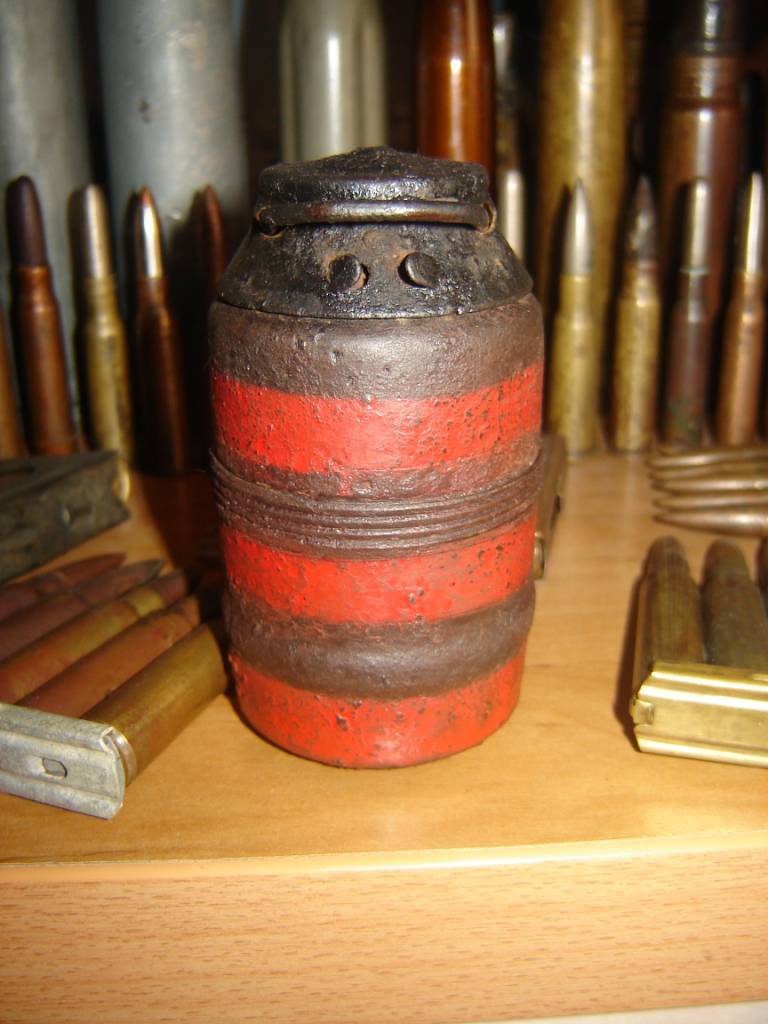
The 36M grenade body (fig. 2) consists of two parts - the 13 cup and the 4 neck, made by stamping from 0,6-mm steel sheet. The neck is screwed into the cup by the thread stamped on the edges of these parts. The end of the neck has a flared hole for guiding the cylindrical liner of the 7 cap and an annular extrusion for checks 6-curved 2,5-mm steel wire that holds the cap on the neck. The tongue is dressed with thick yellow leather, which is fastened to the cap with two limbs, formed by the incision of the conical part of the cap. In the case there is a glass 12, consisting of the lower 15 block with a piece of explosives and a cylinder screwed into it, the bottom of which has an extrusion, where the knot containing the 14 igniter primer (going to be called just the primer) is assembled. The bottom of the cylinder around this capsule has three notches with bends for installing stamped from 0. 6-mm steel cup, which is inserted into the 1 detonator. In the cylinder, the upper 5 unit freely moves with the safety mechanism and the second checker BB. Both checkers of explosives from contact with the metal are protected by a paper wrapper impregnated with an insulating composition. The free movement of the upper block in the cylinder of the glass is braked by an 3 ring made of spring wire with three bends of the ring through rectangular cuts in the glass. The guard mechanism consists of a 10 steel blade, cut from a steel sheet 1,6 mm thick, 2 rocker arm bent from 1-mm brass sheet and a 11 tension spring. When assembling a grenade, first of all, a cap is fixed on the neck, which is fixed by a check, the leather tongue of the check is fixed on the cap by two bends on its conical part. After that, the upper block is screwed onto the 8 screw until it stops. A four-way steel screw with a pitch of a screw 12 mm. The screw is screwed into the rectangular hole 3,5x3,5 mm of the body of the safety mechanism, keeping the sting aside from the primer. Next to the upper block until it stops worn glass 12 with the lower unit, and the neck is screwed with a cup. Between the end of the neck and the bottom of the cap laid sealing gasket. The thickness of the gasket is chosen so that both blocks are assembled without a gap, and the cap is pressed tightly against the end of the neck. The cap and its cylindrical liner, as well as the bodies of both blocks and the glass, are made by stamping from 0,6-mm steel sheet. All steel parts of the grenade are chemically oxidized. On the black surface of the grenade there are three colored stripes, the color of which indicates its type.
When throwing a grenade, if you do not hold the cap, it is partially screwed up with the screw already at the stroke. This occurs under the action of centrifugal force, and it is likely that for this purpose the cap is weighted with two steel discs and a brass tube inside the cylindrical liner of the cap. Additionally, the brass tube serves as a guide for the screw head. The position of the grenade parts is shown in Figure 1. On the initial part of the trajectory, the cap is removed and the upper block is removed from the lower block glass to the bottom of the neck until it stops. After the cap has been completely removed and the upper block has been removed, the 11 spring rotates the beam together with the blade so that the tip of the blade is set against the capsule. This position is shown in Figure 2. When hitting the barrier due to the interaction of the blocks with the inner surface of the body, and by inertia, the blocks move, the sting pushes the cap and the grenade explodes. This position is illustrated in Figure 3. At the same time, when the capsule is pricked, the shoulder of the rocker arm slips along the surface of the extractor with the primer cap, which causes the rocker to turn and release the sting. The sting released from coupling with the yoke is removed by a spring from the zone of interaction with the schooling cap. This is done in order to protect the grenade in the event that, due to a non-energy puncture, the capsule does not work.
Despite all my efforts, for a long time I could not find a description of this grenade. When I was still at the institute, doing a review on hand grenades, I received a pass to the library of a military weapons-technical school opposite to it, but even there my searches were not crowned with success, although the literature on this topic was there. Only relatively recently, I found out the name of this grenade and the name of its designer, and also acquired elements of grenades (by all indications obtained by “black diggers”), which allowed me to create accurate computer drawings of grenades and its layout.
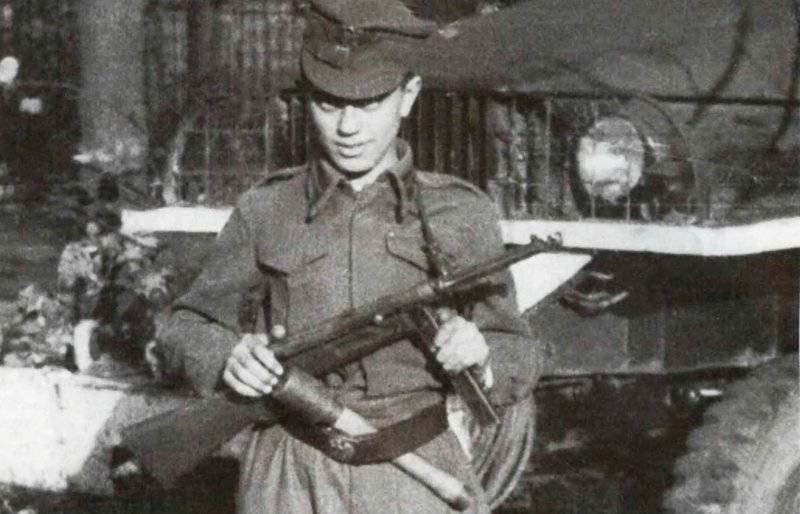
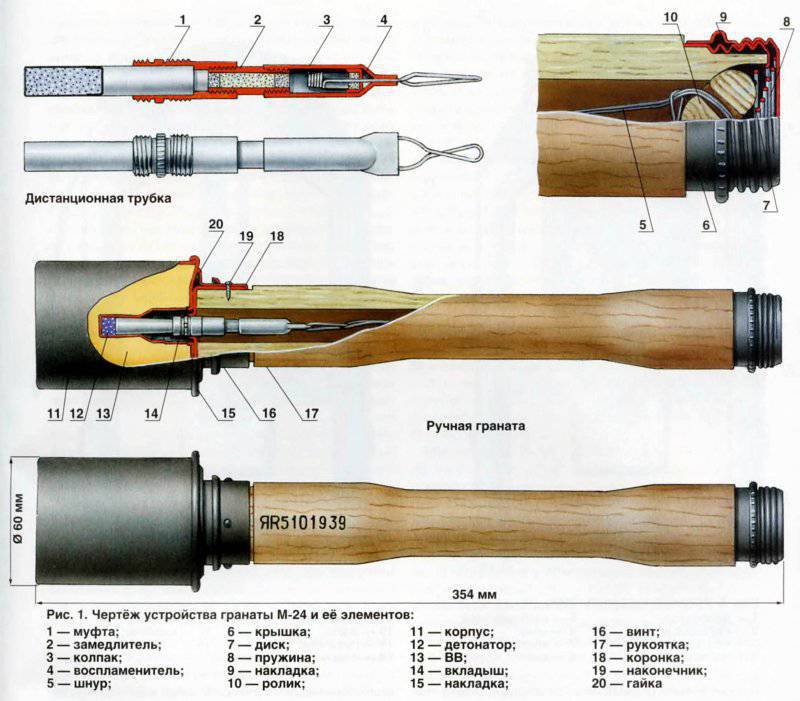
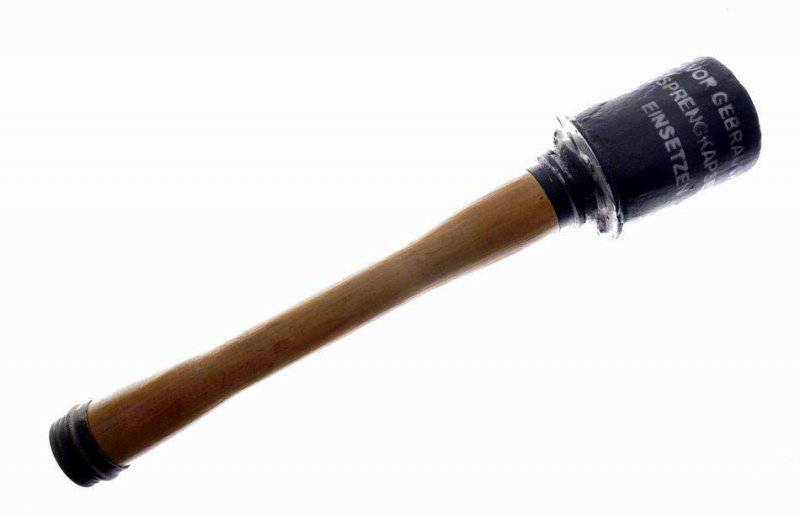
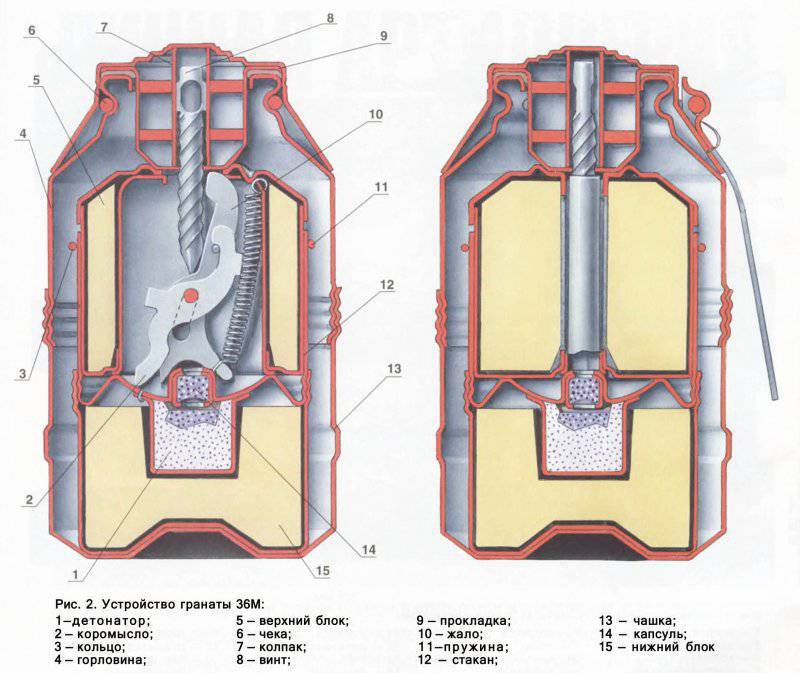
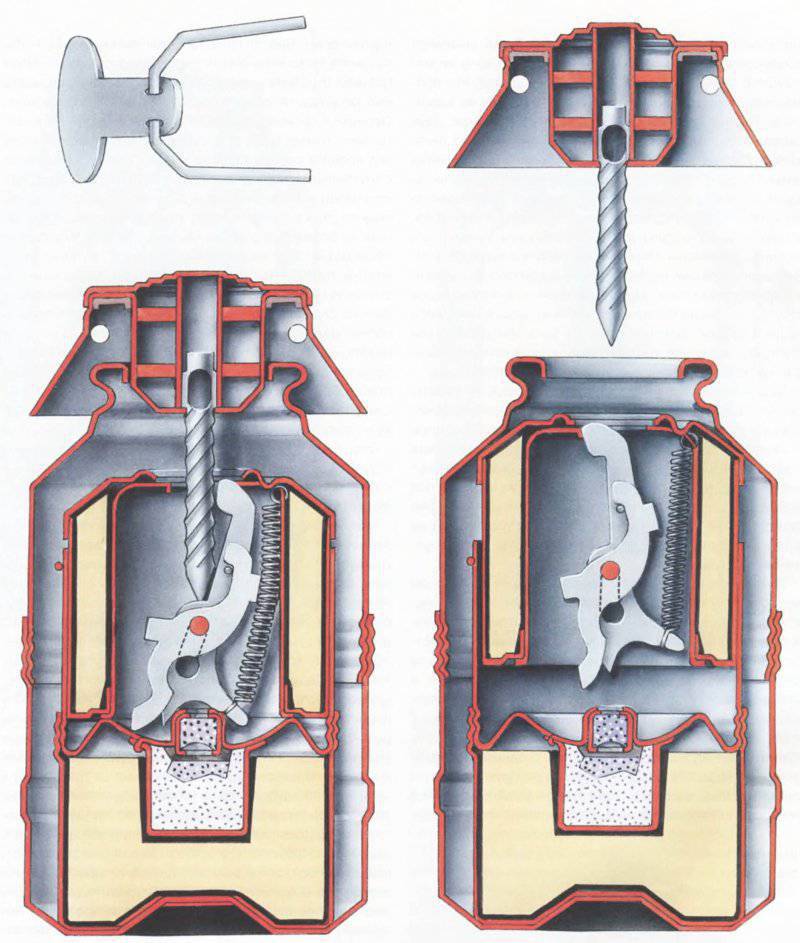
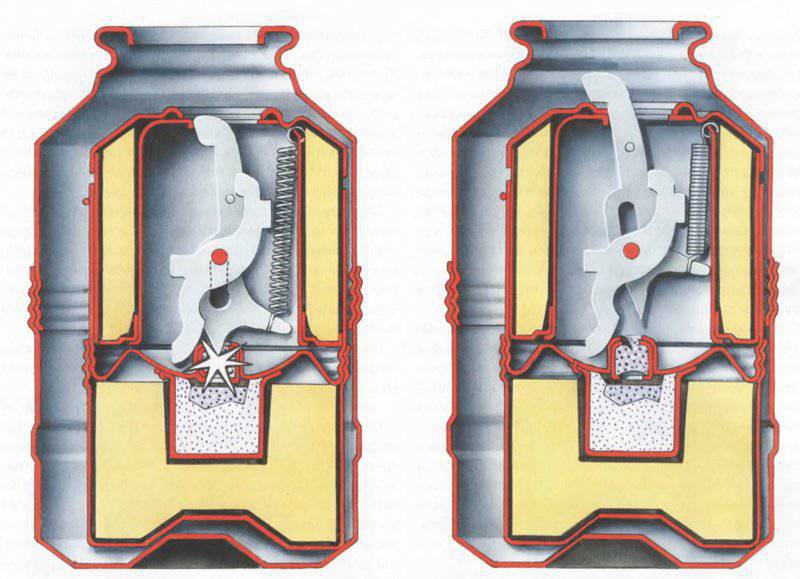
Information